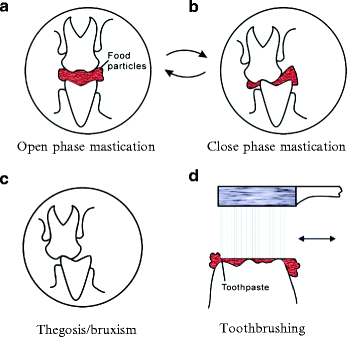, Hai-Yang Yu2, Jing Zheng1, Lin-Mao Qian1 and Yu Yan3
(1)
Tribology Research Institute, Southwest Jiaotong University, Chengdu, People’s Republic of China
(2)
West China College of Stomatology, Sichuan University, Chengdu, People’s Republic of China
(3)
Institute of Advanced Materials and Technology, University of Science and Technology, Beijing, People’s Republic of China
Abstract
Human teeth are not only an important masticatory organ but also closely associated with both the pronunciation and facial aesthetics of humans. Without a doubt, teeth play an extremely significant role in our daily life. The wear of teeth, either natural or artificial, is unavoidable. However, excessive wear may lead to a lack of perfect contact between opposite teeth, a disturbance in the efficiency of the masticatory system, and an obliteration of chewing surfaces. Teeth also play a very important role in animals’ lives. Historically, the wear of teeth has been considered an indicator of age for animals.
Human teeth are not only an important masticatory organ but also closely associated with both the pronunciation and facial aesthetics of humans. Without a doubt, teeth play an extremely significant role in our daily life. The wear of teeth, either natural or artificial, is unavoidable. However, excessive wear may lead to a lack of perfect contact between opposite teeth, a disturbance in the efficiency of the masticatory system, and an obliteration of chewing surfaces. Teeth also play a very important role in animals’ lives. Historically, the wear of teeth has been considered an indicator of age for animals.
The application of tribology in dentistry is a growing and rapidly expanding field. Intensive research has been conducted to develop an understanding of dental tribology for the purposes of a better selection of artificial dental materials and the design of implant teeth. Dental wear, or dental biotribology, has been one of the most important branches in biotribology in recent years.
1.1 Biotribology
Although wear, friction, and lubrication have been studied for many years, the term “tribology” was first introduced in 1966 in the Jost Report and was defined as “the science and technology of interacting surfaces in relative motion and the practices related thereto.” In brief, tribology deals with lubrication, friction, and wear, which include a number of basic disciplines such as mechanics, material science, chemistry, and physics, among others. For decades, industrial problems have been responsible for the recognition of the concept of, and the word, “tribology.” Typical engineering components such as ball bearings, gears, and wheels have been widely investigated. However, it soon became obvious that an understanding of the nature of the interaction a between loaded and moving surfaces would be equally important in studies of biological systems. The word “biotribology” was first used in 1970 and defined by Dowson and Wright in 1973 as “those aspects of tribology concerned with biological systems” [1].
Biotribology is currently one of the most exciting and rapidly growing areas of tribology. The range of research activities is immense and spans many scientific fields. A considerable number of papers on biotribology have been published in various journals. In addition, many sessions of conferences, national or international forums, workshops, and symposia have been held on biotribology or on topics related to it. For example, in 1967, the symposium on Lubrication and Wear in Living and Artificial Human Joints was organized and held in London by the Institution of Mechanical Engineers in collaboration with the British Orthopaedic Association; it attracted over 160 delegates. In 1996, a report of a workshop organized by Lloyd et al. was published. Eighty delegates contributed to a valuable discussion; the purpose was to bring together tribologists, clinicians, and dental materials scientists to discuss the fundamental mechanisms of wear and how to obtain manifestations and conduct measurements of wear in dentistry [2]. Subsequently, the First Vienna Symposium on Biomechanical Engineering was organized during the 2nd World Congress on Tribology in 2001. The Symposium on Human-related Tribology during the 4th World Congress on Tribology in 2009 and the 6th International Biotribology Forum in 2011 were also held [3–6]. However, the meeting with the largest scale was the 2011 International Conference on Biotribology held at Imperial College, London [7]. To the surprise of the Organizing Committee, 175 abstracts for oral and poster presentations on various subjects were received, such as artificial hip joints, skin and haptics, personal care products, articular cartilage, human teeth, lifestyle and home healthcare devices, artificial heart valves, bones, hair, and eyes, and about 300 delegates from over 20 countries participated in the conference, which shows the growth and diversity of the research area of biotribology. Evidently, there have been many more scientific sessions on the topic of biotribology in various conferences and meetings. This shows that biotribology has been one of the most studied and active research areas in the field of tribology.
1.2 Classifications and Definitions
According to the Organization for Economic Cooperation and Development’s (OECD) Glossary of Terms and Definitions in the field of friction, wear, and lubrication (tribology), wear is defined as http://stats.oecd.org/glossary/ “the progressive loss of substance from the operating surface of a body occurring as a result of relative motion at the surface.” In the field of tribology, five wear mechanisms rather than wear modes have been frequently recognized: abrasion, adhesion, fatigue, erosion, and corrosion. In most cases, two or more wear mechanisms combine together and contribute to the material degradation processes.
Wear by abrasion is associated with the displacement of material from a relatively soft solid by the protuberances on a harder counterface, or by loose, harder particles between two surfaces. Adhesive wear is the process by which material is transferred from one surface to another during relative motion. Fatigue wear is frequently related to the formation of surface or subsurface cracks, and then particles of detachment under repeated and higher contact stress condition. Wear by erosion mainly describes surface damage in either a liquid–solid or gas–solid flow system. Corrosive wear is considered substance loss under chemical or electrochemical action often combined with relative motion. Fine debris detached from the surface and fresh contact surface exposed to be oxidized are typical forms of corrosive wear.
With the help of an Internet search engine (http://scholar.google.com) in July 2012, on the keywords “teeth and wear,” more than 400,000 pieces of information are recorded mainly in the archaeological and medical literature, extending over many centuries. Dental wear is considered a tribological problem. However, major research papers that have been published in various medical journals related to dental research, dental material, oral rehabilitation, and the like focus on the consequences of dental wear but not on the mechanisms of dental wear [8–10]. This book will illustrate why researchers and dental scientists need a deepened understanding of the behaviors of dental wear.
In the dental literature, there are many different classifications and definitions to describe tooth surface loss, including surface wear [9, 10]. A representative overview on tooth wear was made by Imfeld [11]; six kinds of noncarious tooth loss, including abrasion, attrition, erosion, abfraction, resorption, as well as demastication, were identified, as listed in Table 1.1.
Table 1.1
Classifications and definitions of tooth surface loss
|
Mode
|
Definition
|
|---|---|
|
Abrasion
|
The pathological wearing away of dental hard tissue through an abnormal mechanical process involving foreign objects or substance repeatedly introduced in the mouth and contacting the teeth
|
|
Attrition
|
The physiological wearing away of dental hard tissue as a result of tooth-to-tooth contact with no foreign substance intervening
|
|
Erosion
|
The physical result of a pathologic, chronic, localized, painless loss of dental hard tissue chemically etched away from the tooth surface by acid and/or chelation without bacterial involvement
|
|
Resorption
|
The process of biological degradation and assimilation of substances or structures previously produced by the body
|
|
Abfraction
|
A special form of wedge-shape defect at the cementoenamel junction of a tooth
|
|
Demastication
|
The wearing away of tooth substance during the mastication of food with the bolus intervening between opposing teeth
|
In most cases, the terms “dental abrasion,” “attrition,” “erosion,” and “abfraction” have been frequently used in the field of dental research. However, it should be noted that the definition and classification of tooth surface lesions have been in a state of confusion when used in tribology terminology. For example, there is no such term “attrition” in the research of general wear for tribologists. In fact, “attrition” merely indicates a two-body contact, such as tooth to tooth or tooth to denture contact by mastication, and it is not considered to cause any damage. However, based on tribological terms, “attrition” would be clearly subsumed under other well-defined surface damage mechanisms. Moreover, there is a huge difference in the definitions of the term “erosion.” It seems that the meaning of “erosion” used in tooth loss is similar to that of “corrosion” used in tribology. In 2004, Grippo et al. [12] also proposed that the term “erosion” should be deleted from the dental lexicon and replaced with the term “corrosion” to denote chemical dissolution of teeth. In addition, “abfraction” is more or less related to higher bite force or repeated contact load, pointing to a relationship with the effect of fatigue. It might potentiate tooth wear by abrasion and/or erosion. On the contrary, the term “adhesion,” which is widely used in the field of tribology, is not encountered in the dental literature. The explanation might be that dental tissue, particularly dental enamel, is similar to ceramic materials; perhaps adhesive wear would not occur at the tooth surface during the masticatory process. Nevertheless, respecting disciplinal differences and development history, these terms will still be used although engineers and medical researchers should use care when reading these terms in the literature.
1.3 Anatomy and Function of Human Teeth
Human teeth possess a unique structure [13] composed of enamel, the dentin–enamel junction, dentin, and pulp (shown in Fig. 1.1); each zone is anisotropic. The two most important elements of a tooth from a tribological perspective are the outer enamel and the inner dentin, whose properties [14] are given in Table 1.2.
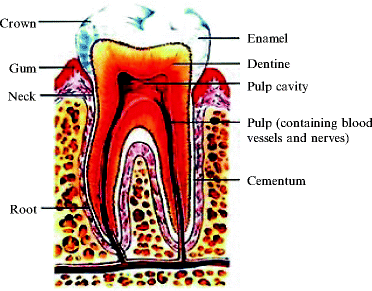

Fig. 1.1
Human tooth structure [13]
Table 1.2
Mechanical properties of enamel and dentin
|
Property
|
Dentin
|
Enamel
|
|---|---|---|
|
Young’s modulus (GPa)
|
10.2–15.6
|
20.0–84.2
|
|
Shear modulus (GPa)
|
6.4–9.7
|
29
|
|
Bulk modulus (GPa)
|
3.11–4.38
|
45.65
|
|
Poisson’s ratio
|
−0.11–0.07
|
0.23, 0.30
|
|
Compressive strength (GPa)
|
0.249–0.315
|
0.095–0.386
|
|
Tensile strength (GPa)
|
0.040–0.276
|
0.030–0.035
|
|
Shear strength (GPa)
|
0.012–0.138
|
0.06
|
|
Knoop hardness
|
57–71
|
250–500
|
|
Density (kg/m3)
|
2,900
|
2,500
|
Enamel is the hardest tissue in the human body, while dentin is usually considered to be elastic and soft. Initially, the enamel, which has a thickness of 2–3 mm, is exposed to the occlusal surface and chemical environment within the mouth. Enamel is composed of 92–96 % inorganic substances, 1–2 % organic materials, and 3–4 % water by weight [15]. Most of the inorganic substances are hydroxyapatite, which is contained in the basic structural unit of enamel, the rod or prism. These prisms align and run approximately perpendicular from the dentin–enamel junction toward the tooth surface [16–18]. The high hardness of enamel is attributed to its high mineral content, while its brittleness is due to its high elastic modulus and low tensile strength. Investigations have shown that the mechanical properties of enamel vary with locations on a tooth, local chemistry, and prism orientation [18–20]. Finite element stress analysis results showed that the enamel absorbs most of the applied chewing load during mastication due to its greater stiffness as compared to dentin; therefore, masticatory forces tend to flow around the enamel cap to the root dentin [21].
Dentin is a hydrated biological composite composed of 70 % inorganic material, 18 % organic matrix, and 12 % water by weight, and its properties and structural components vary with locations [22]. The structural composition of dentin includes oriented tubules surrounded by a highly mineralized cuff of peritubular dentin and an intertubular matrix consisting of type I collagen fibrils reinforced with apatite. Between enamel and dentin, the dentin–enamel junction, a biological interface, may dissipate stresses, inhibiting further crack propagation [23, 24]. The dentin–enamel junction has a high fracture toughness and, along with the more resilient underlying dentin, supports the integrity of enamel by preventing its fracture during function. Another possible mechanical function of the soft dentin beneath the dentin–enamel junction may be related to the ability of a whole tooth to resist impact forces, which often occur when the tooth is working [25].
The major functions of teeth, together with any restorations and implants, are associated with speech, breathing, tasting, and chewing, and with supporting bone, soft tissues, and the muscles of mastication. Initially, a human has 20 primary (or baby) teeth [26]. These are eventually replaced, during childhood, with 32 permanent (or adult) teeth. To allow chewing, teeth are arranged into two opposing arches in the mouth. Within each arch are different types of teeth (Fig. 1.2), each of which has a different function. Incisor teeth are used for shearing, the canines evolved for holding prey, and molars are used for chewing. In general, molars have complex surfaces and cusps that fit together in a dynamic way during the chewing process. Figure 1.2 also illustrates different surfaces of teeth. The buccal side is nearest the side to the lips or cheek; the lingual side is closest to the tongue. The occlusal surface, the main site of tooth wear processes, is the side that meets a tooth or restoration material in the opposite jaw during chewing or biting. In addition, the side of one tooth in contact with a proximal other tooth is defined as the approximal surface; each tooth has two approximal surfaces.
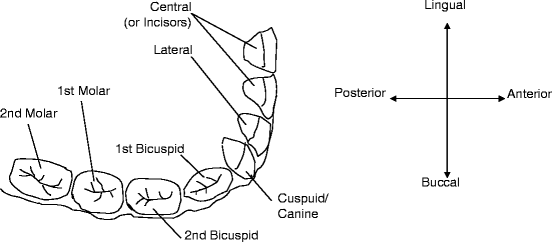

Fig. 1.2
Human tooth orientation [26]
1.4 Biomechanics of Human Teeth
Mastication is the most important function of teeth. It has been widely accepted that wear of dental materials in the mouth mainly results from chewing cycles. Therefore, it is important to understand the biomechanics of mastication. Mastication is the action of chewing food, which is a complex and compound process [27]. Mastication involves two stages: the open phase and the closed phase [28]. During the first stage, the teeth are brought by the jaw from the open position to a position of contacting the food bolus. Normally, no occlusal forces are involved in this phase (sticky foods represent an exception), and the abrasive particles are suspended and free to move in the food slurry. The second stage starts when the teeth first contact the food bolus and continues until the jaw begins to open. During this phase, occlusal loads are applied and distributed through the food bolus so the food particles are trapped between the opposing surfaces of teeth (especially the upper and lower molars) and dragged across them. Therefore, the food bolus is compressed and crushed, and then grinding occurs with either tooth–food–tooth (or indirect) or direct tooth–tooth (complete penetration of the food bolus, if present) contacting of the opposing teeth surfaces [29]. A simplified drawing of the chewing cycle is displayed in Fig. 1.3.
Literature shows that the shape of the occlusal force curve is similar to the positive half of a sine curve, but asymmetric mainly because of the irregularity of some foods [30, 31], as shown in Fig. 1.4. During normal chewing, the loads applied to the teeth are in the range of 10–20 N at the initial contact [32] and are increased to the range of 50–150 N at the end of the chewing cycle [33, 34]. The magnitude of the force depends mainly upon the physical properties of food. Given the great variety of foods, various forces can be expected. In addition, the maximum biting forces vary according to gender, age, and muscle build. Typically, the maximum biting load at the incisors is 100 N, gradually increasing as one moves posteriorly, to reach around 500 N at the molars.


Fig. 1.4
Relationship between sine curve and masticatory loading patterns [29]
General chewing parameters [26, 27, 35] are listed in Table 1.3. The total duration of a chewing cycle has been shown to be about 0.70 s, while the mean duration of the occlusion is about 0.10 s [27], and these periods add up to 15–30 min of actual contact loading each day [26]. The speed of teeth sliding ranges between 0.25–0.50 mm/s. Tooth-on-tooth sliding distances are around 0.9–1.2 mm [26]. These parameters vary widely and depend on the kind of food, the size of the food bolus, the chemical and physical actions of saliva, and psychological factors [27].
Table 1.3
Interoral chewing parameters
|
Chewing
|
Sliding speed
|
Sliding
|
Duration (s)
|
||
|---|---|---|---|---|---|
|
Chewing load (N)
|
frequency (Hz)
|
(mm/s)
|
distances (mm)
|
Total
|
Occlusion
|
|
2–150, Max 450
|
1–2
|
0.25–0.50
|
0.9–1.2
|
0.70
|
0.10
|
Except for mastication, other functions, such as thegosis and bruxism (Fig. 1.3), also can result in friction and wear of dental materials [28]. Thegosis is the action of sliding teeth into lateral positions. This has been suggested to be a genetically determined habit originally established to sharpen teeth [36]. Bruxism is the action of grinding teeth without the presence of food, which is regarded as a response to stress and treated clinically as pathologic behavior [28]. During thegosis and bruxism, occlusal forces guide the movement of the lower jaw relative to the upper jaw and thereby cause friction and wear of teeth and restorations in direct contact (tooth–tooth or tooth–restoration or restoration–restoration). In addition, tooth cleaning (for instance, toothbrushing) and habits such as pipe-smoking and pencil chewing can also cause friction and wear of teeth and restorations [28, 37].
It is noteworthy that during mastication, thegosis, and bruxism, a relative motion between the proximal teeth can cause friction at proximal contacts and then result in interproximal wear of dentition. Under physiological loads (Fig. 1.4), the biological thresholds for micromovements at the proximal contacts are arguably in the range of less than 100 μm. As a result, a tooth motion of this type is usually undetected and neglected.
1.5 A Brief History on Dental Wear
Clinicians have paid attention to the issue of dental friction and wear for hundreds of years. In 1778, the English anatomist and physiologist John Hunter published the first textbook for dentistry, The Natural History of Human Teeth [38]. In his book, Hunter presented many physiological and pathological properties related to the teeth, such as the upper and lower jaws, alveolar processes, structure and formation of the teeth, and diseases and their effects in dentition; however, there was little description of dental lesions.
1.5.1 Dental Erosion
In the past, dental erosion was very common due to industrial pollution and dietary acids such as acidic soft drinks [10]. The typical features of the teeth are shown in Fig. 1.5. According to an incomplete literature examination, the earliest report on tooth erosion was published in 1892 by Darby [39]. In the middle of the twentieth century, some investigations on dental erosion were reported due to atmospheric contamination from the rapid development of the chemical industry [40–43]. A large-scale examination on hundreds of acid workers was performed by Ten Bruggen Cate [44]. He showed that the dentin was affected, that the degree of erosion progressed during the period of the survey, and that erosion superimposed upon attrition predisposed to a more severe loss of tooth structure than either operating alone.
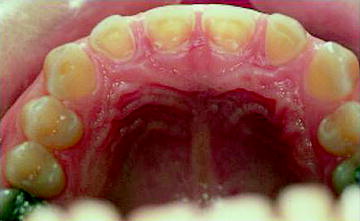

Fig. 1.5
Palatal view of maxillary teeth of a 16-year-old female who had drunk a liter of “diet” carbonated drinks a day for the past 2 years. There is marked tooth surface loss affecting the anterior [10]
The irreversible loss of dental hard tissue induced by acids is accompanied by a demineralization and softening of the tooth surface. This dematerialized surface is more prone to abrasion through mechanical friction such as toothbrushing, as studied by Davis and Winter [45] and Attin et al. [46] However, Featherstone [47] showed that human saliva had the capacity to reharden enamel that was demineralized in the form of an incipient carious lesion, suggesting that saliva assists the repair of surface demineralization caused by acidic substances. In 1998, Edwards et al. [48] recommended that people should avoid brushing their teeth for at least one hour after having a soft drink in order to minimize tooth substance loss by tooth abrasion. However, Jaeggi et al. [49] indicated a period of 1 h for an exposure to saliva was not sufficient to reestablish the abrasion of the enamel of eroded surface as compared to the uneroded. A similar conclusion was obtained by Attin et al. [50], that the abrasion resistance of softened enamel increases with the length of the remineralization period, and at least 1 h should be allowed before toothbrushing after an erosive attack. Further investigations confirmed that the remineralization was also sufficiently long in the case of exposed dentin areas.
The effect of water fluoridation upon dental erosion in the UK has been investigated by Bardsley et al. [51]. They found that children in nonfluoridated districts were 1.5 times more likely to have smooth surface wear compared with children in fluoridated districts. They recommended that fluoridation and the use of fluoridated toothpaste twice a day provided added protection from dental erosion. Devlin et al. [52] measured the surface hardness of human enamel exposed to Coca-Cola and artificial saliva. Similar results were obtained by Tantbirojn et al. [53]: The hardness was significantly reduced after immersion in a cola drink, which represented the early stage of erosion. Hardness improved after four applications of a paste containing casein phosphopeptide amorphous calcium phosphate, with a continuous replenishment of saliva-like solution (Fig. 1.6).
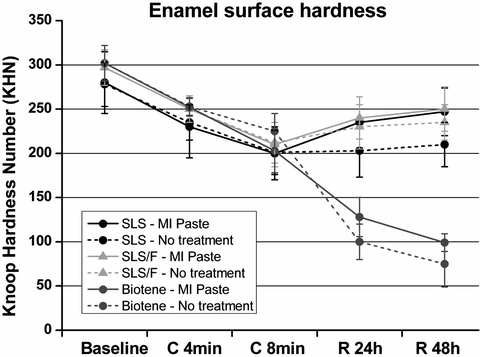

Fig. 1.6
Enamel surface hardness at different time intervals during the experiment. C4 min and C8 min were 4- and 8-min immersion in a cola drink. R24 h and R48 h were 24- and 48-h remineralization [53]
1.5.2 Dental Caries
Dental caries, a kind of oral disease with a high prevalence worldwide, is a dynamic dietomicrobial disease involving cycles of demineralization and remineralization. The disease is usually divided into three types: superficial caries, middle caries, and deep caries. Superficial caries can be treated with various methods to prevent further damage, while the latter two require the filling of artificial material.
The early stages of dental caries are reversible by modifying or eliminating etiologic factors such as plaque biofilm and diet, and increasing protective factors such as fluoride exposure and salivary flow. The effectiveness of dietary measures to prevent caries is limited, as today’s diets are complex and include various compositions leading to caries, such as carbohydrates and acids. It is known that reducing the amount and frequency of the consumption of caries-causing foods, such as soft drinks and sugar, is important for people at a high risk of developing caries. Yet anticaries properties are attributed to some foods, such as milk, dairy products, and sugar-free gum [54–56]. Recently, some researchers practicing clinical studies in Europe showed that early caries could be repaired by saliva if fluoride application was combined with the regular removal of bacteria plaque [57].
Epidemiological evidence demonstrated that water fluoridation decreased the prevalence of caries in both children and adults. The results of animal experiments and clinical trials supported topical fluoride application and the safe and effective use of fluoride. Away from water fluoridation, fluorides of various valences, such as amine fluoride, sodium fluoride, stannous fluoride, and titanium tetrafluoride, have been widely studied and utilized in research on enamel erosion for further application to dental caries, yet their conclusions ranged from no effect to excellent effect [58]. Gao et al. evaluated the effect of remineralization treatment by NaF on the wear behavior of human early carious enamel using a nanoscratch tester [59]. The results showed that the hardness and density of carious enamel increased obviously after remineralization, but its friction coefficient became higher. Furthermore, more cracks and debris appeared on the worn surface of remineralized enamel. It seemed that fluoride, the most effective remineralization agent clinically, could decrease the wear resistance of early carious enamel.
Stay updated, free dental videos. Join our Telegram channel

VIDEdental - Online dental courses


